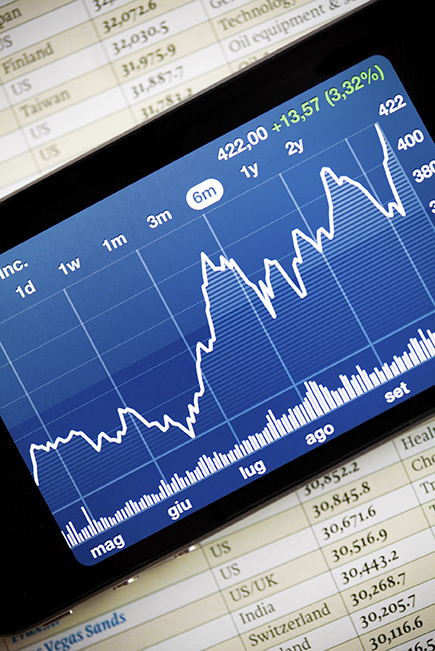Lingering ambiguities dragged down the Tehran Stock Exchange (TSE)’s overall index to break below 65,000-point mark resistance level at Monday’s close, with the free float index topping market laggards.
According to TSE data, the TEDPIX continued its rout, and plummeted 448.8 points or 0.69 percent to spur concern among panicked investors, who have already lost about 40 percent of their portfolios’ worth.
The first market tumbled 350 points or 0.73 percent to stand at 47,817.3. The second market index slipped 755.3 points or 0.59 percent to end at 127,705.7. The free float index topped the red indices, and shed 682.7 points or 0.91 percent to settle at 73,984.1. The industry index was also down 260.1 points or 0.48 percent to finish at 54,495.6, and the blue chip index lost 20.7 points or 0.71 percent to keep falling to 2,905.1.
Most of the listed companies at the TSE registered downbeat performance for the second time in the week. Prevailing fluctuations at the TSE are not following a regular path, as some companies top the list of positive contributors to the TEDPIX one day, while they become the biggest losers another day.
More than 543 million shares changed hands in a downward trading day on Monday, valued at almost 1 trillion rials. Both trade volume and value declined in comparison with the prior trading day.
The TSE data illustrate that major companies at the TSE were among the laggards, including National Iranian Copper Industries Company, Mine and Metals Development Investment Company, and Islamic Republic of Iran Shipping Lines.
The Parsian Oil and Gas Development Company with almost 18-point positive contribution tried to give a lift to the benchmark; however the fragile atmosphere of the equity market forced TEDPIX to notch a new record low within the past 15 months. More than 80 percent of the listed firms settled in red, with financial groups leading the losers. Among the listed banks in the spotlight, Mellat Bank left the most negative impact on the TSE’s benchmark. Saderat Bank and Tejarat Bank stood next and were named Monday’s main market laggards.
Brittle State
Stocks at the equity market took a thrashing on Monday as mounting concerns over the gloom hanging over the economy due to the western sanctions keep driving investors to uncertain directions with unsettled overreacting behavior at the equity market.
As Iran and the P5+1 are approaching the late March deadline to work out the main outlines of a comprehensive nuclear accord, uncertainties along with shaky investors’ trading sentiment are weighing on the benchmark. The deadline for a detailed agreement is the end of June. “Sanctions are a liability; you need to get rid of them if you want a solution,” Iran’s Foreign Minister Mohammad Javad Zarif told a security conference in Munich. “Now it’s time to do it, and we need to seize this opportunity,” he said, speaking about the efforts to forge an agreement, adding that “it may not be repeated.”
The dramatic record low on Monday trading at the TSE sounds alarm for market activists mainly governmental bodies like the Securities and Exchange Organization (SEO).
New Indices
If you invest in mutual funds or individual stocks then it is key to measure the performance of your investments against a relevant market index. If investments consistently lag behind the index, then it might be time to come up with a new investing strategy.
By gaining a clear understanding of how indices are created and how they differ, investors will be on their way to making sense of the daily movements in the marketplace. Here they will compare the main market indices to have a clear idea of what is actually going on in the market.
As the companies that weigh heavily on the TSE happen to push the gauge both up and down, the current overall index could not be a solid indicator for investors to map their trade strategies.
The head of the SEO said at a press conference that new indices are on the way to the equity market to help investors rely on right indicators.
The Financial Tribune interviewed Hossein Khezli Kharazi, CEO of Noor-e-Anvar financial holding on the importance of having various indices for different segments at the equity market.
Kharazi backed the idea of creating new indices at the equity market and indicated that the TEDPIX is calculated via a weight-based method called Laspeyre, adding that “each index can give the right information to relevant investors, as a variety of investors are engaged in the equity market”. He also underlined that when it comes to decision making based on indices, various indicators should be taken into consideration. For instance, there should be an index, which excludes inflation from calculation in a bid to find out real return out of investment.
The stock market has a batch of data, each might be of interest to different investors and one index might prove more handy to certain investors than the overall index, said Kharazi, adding that trade volume usually reveals more information about the stock market atmosphere. He further pointed out that the equity market ‘turnover ratio’ is another implication of how dynamic or profitable an equity market is.
Turnover ratio is the total value of shares traded during the period divided by the average market capitalization for the period. “The ratio in Iran has surged from 12 to 24 percent since 10 years ago, however in some countries the ratio is over 120 percent,” said Kharazi. The bottom line is that Iran’s equity market is grappling with many lagging indicators. Since the TSE’s sentiment is tied to the nuclear negotiations, it is not expected to witness a practical shift in its performance.


